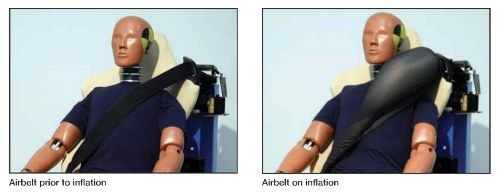Takata Airbelt – Cool Technology, But Is It Cost Effective?
Benjamin | Mar 09, 2011 | Comments 2
Airbag design has progressed a long way since the early 1990’s, when dash-mounted units were the only secondary restraint systems available. In the intervening two decades forward airbags have gained multi-stage capability and a host of new airbag location points have sprung up in vehicle passenger compartments. It is no longer uncommon for airbags to be found attached to the side of seats or nestled inside A-pillars in order to protect heads and torsos from side impacts.
The latest development in airbag design has been unveiled by the Takata Corporation, a Japanese safety systems manufacturer. Called the Takata “Airbelt,” the new protective device is essentially what it sounds like – an inflatable seatbelt that takes the place of traditional automobile seat belts.
The Takata Airbelt integrates an airbag into special webbing found on the seatbelt itself, and the unit is intended to help dissipate the energy associated with the human body being restrained by the belt during a crash. The inflation is focused between the head and the shoulder on the side facing the outside of the car, which can also help to prevent injury related to head movement or cockpit intrusion.
The Airbelt will see its passenger car introduction in the Lexus LFA, a limited production supercar that is currently available for lease from the brand. Toyota has yet to make it clear as to whether the Airbelt is a technology that will gradually trickle down into its more affordable passenger cars, or whether the device remains cost prohibitive for use outside of automobiles with six figure MSRPs.
A further question regarding the Airbelt has to do with its actual utility. Given that side impact airbags are already available on almost every vehicle, is it really necessary to enhance that protection with yet another side impact device? Particularly if the Airbelt is so pricey that it has yet to be introduced outside of the supercar world?
It would also seem as though the positioning of the Airbelt would play an important role in how effective it is at protecting occupants from injury. Illustrations provided by Takata show the device expanding between the head and shoulders of the driver, which begs the question of how the belt can accommodate drivers of different heights.
The Takata Airbelt certainly won’t negatively impact safety when deployed in an accident, but the question of whether it offers substantial improvements in overall collision protection remains unanswered.
Filed Under: Auto News



The seatbelt that’s an airbag can help people from being ejected in a rollover. By the airbag filling up keeping you tight in the seat will keep you from slipping out the window. Only thing that I can see as a potential issue is the adjustment of where the belt sits at the neck.
Mickey – Good call on reducing risk of ejection – it would be interesting to see some data, but that makes a lot of sense.